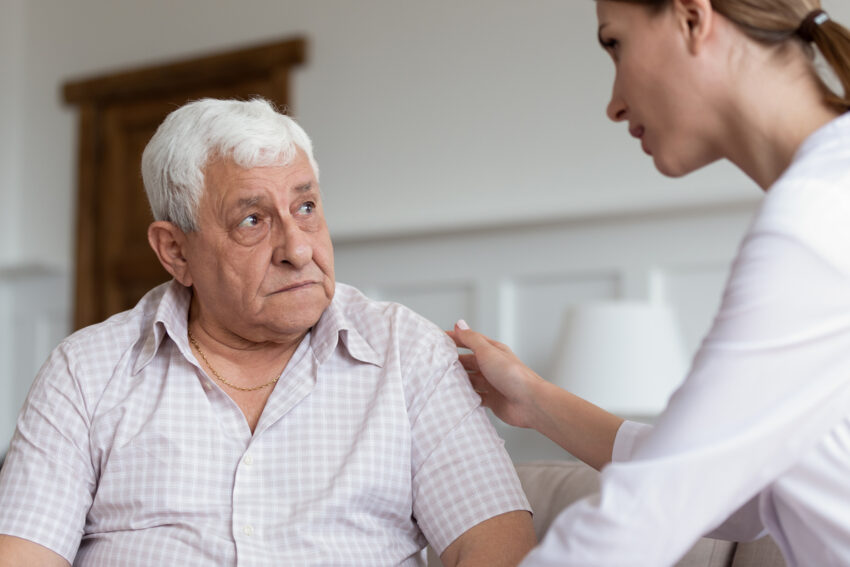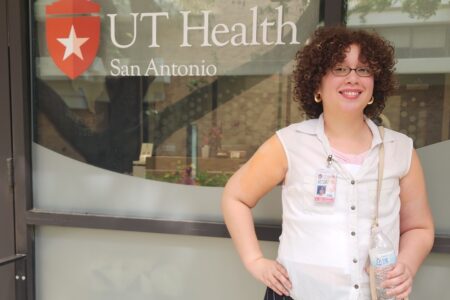
Share On Social!
A stroke occurs when a blood vessel that carries oxygen and nutrients to the brain is either blocked by a clot or bursts.
Every year, more than 795,000 people in the United States have a stroke.
Many know the acronym FAST that helps identify a stroke – F (face drooping), A (arm weakness), S (speech), and T (time to call 911) – and can spur quick action to save lives.
What can those who speak Spanish use? What does strokes in the Latino community look like?
Using RÁPIDO to Identify a Stroke
While the FAST acronym can be helpful in spotting a stroke, it doesn’t translate well in Spanish.
In fact, just 58% of Latino adults in the U.S. can recognize stroke signs, compared to 64% of Black adults and 71% of white adults, according to a CDC report.

“Studies show that while Hispanic adults currently have a similar rate of stroke as their non-Hispanic white counterparts, they are not as aware of the symptoms,” according to the American Heart Association.
In 2021, UT Health Houston researchers developed the Spanish-language acronym, RÁPIDO.
RÁPIDO stands for R (rostro caído), Á (álteración del equilibro), P (pérdida de la fuerza en el brazo una pierna), I (impedimento visual repentino), D (dificultad para hablar), O (obtén ayuda y llama al 911).
Removing language barriers is important for Latinos, who face this challenge frequently when it comes to healthcare.
“Latinos who primarily speak Spanish are more likely to lack a usual source of care, have fewer outpatient visits, and receive fewer prescription medications than Latinos who are English proficient,” according to the US Department of Health and Human Services.
Culturally relevant and accurate health information can make a big difference in Latino patients.
“Consequently, the development of efficient and culturally sensitive stroke screening tools that address this challenge represents a substantial stride toward our goal of bridging important quality gaps observed in stroke care,” said Dr. Fernando Testai, director of vascular neurology and a professor at the University of Illinois at Chicago College of Medicine.
Latinos and Stroke Rates
Stroke is the No. 3 cause of death for Latino women and No. 4 for Latino men, the American Heart Association reported.
Latinos face many health issues that make stroke more common, including:
Social determinants of health can also be considered as a risk factor in stroke for Latinos.
“These factors can affect your ability to obtain medication, get physically active and otherwise relieve stress. Some social determinants that can affect your health include education, health care access, language barriers, neighborhoods and social communities,” according to the American Stroke Association.
While the risk factors for heart issues and stroke are high for Latinos, prevention is key.
The American Stroke Association identifies several ways to reduce the risk:
- Eat more fruits and vegetables
- Reduce salt in your diet
- Increase your physical activity
- Quit smoking (or not start). Try Quitxt, a bilingual service from UT Health San Antonio and the Cancer Prevention and Research Institute of Texas that sends texts messages to smartphones to help South Texas adults quit smoking. Messages from Quitxt help with motivation to quit, setting a quit date, handling stress, and using nicotine replacement, if needed. To join Quitxt in English, text “iquit” to 844-332-2058. For Spanish, text “lodejo” to 844-332-2058. More than 1 in 5 Quitxt users fully quit smoking after completing the English version of the program, according to a 2017 study.
- Maintain a healthy weight (your health care team can help you figure out yours)
- Manage stress
- Talk with your health care team about your risk factors so you can understand how to manage them
Visit stroke.org for educational tools and resources for patients, families, and caregivers.
How Healthy Is Your Community?
It’s important for Latinos and their familias to take care of their health.
But what about the health of your community?
Through the Health Equity Report Card by Salud America! at UT Health San Antonio, you can explore maps, data, and gauges to compare public health issues to the rest of your state and nation.
Share the results from the report card with city leaders, health departments, and social justice organizations to start conversations about health disparities and advocate for change in your area.
GET YOUR HEALTH EQUITY REPORT CARD!
Explore More:
Healthcare AccessBy The Numbers
142
Percent
Expected rise in Latino cancer cases in coming years



